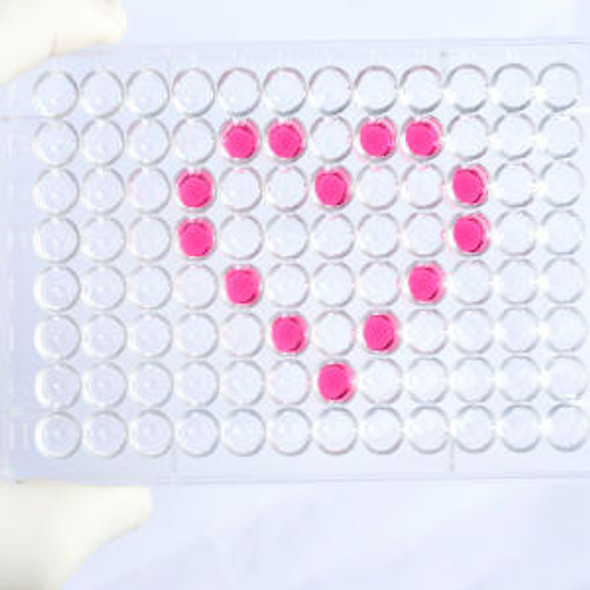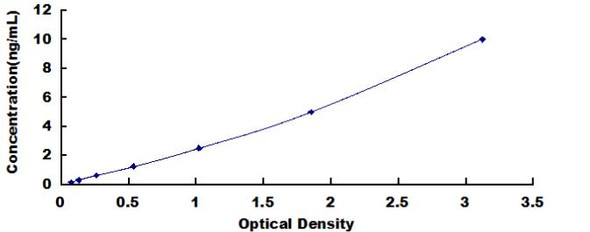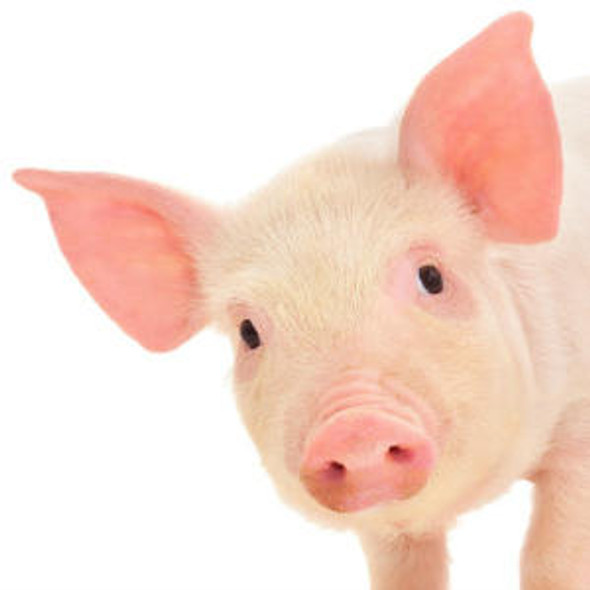Human Cell Biology ELISA Kits 6
Human GUS beta ( beta-glucuronidase) ELISA Kit (HUES02113)
- SKU:
- HUES02113
- Product Type:
- ELISA Kit
- Size:
- 96 Assays
- Uniprot:
- P08236
- Sensitivity:
- 0.09ng/mL
- Range:
- 0.16-10ng/mL
- ELISA Type:
- Sandwich
- Reactivity:
- Human
- Sample Type:
- Serum, plasma and other biological fluids
- Research Area:
- Cell Biology
Description
| Assay type: | Sandwich |
| Format: | 96T |
| Assay time: | 4.5h |
| Reactivity: | Human |
| Detection Method: | Colormetric |
| Detection Range: | 0.16-10 ng/mL |
| Sensitivity: | 0.10 ng/mL |
| Sample Volume Required Per Well: | 100µL |
| Sample Type: | Serum, plasma and other biological fluids |
| Specificity: | This kit recognizes Human GUS beta in samples. No significant cross-reactivity or interference between Human GUS beta and analogues was observed. |
This ELISA kit uses Sandwich-ELISA as the method. The micro ELISA plate provided in this kit has been pre-coated with an antibody specific to Human GUS beta. Standards or samples are added to the appropriate micro ELISA plate wells and combined with the specific antibody. Then a biotinylated detection antibody specific for Human GUS beta and Avidin-Horseradish Peroxidase (HRP) conjugate are added to each micro plate well successively and incubated. Free components are washed away. The substrate solution is added to each well. Only those wells that contain Human GUS beta, biotinylated detection antibody and Avidin-HRP conjugate will appear blue in color. The enzyme-substrate reaction is terminated by adding Stop Solution and the color turns yellow. The optical density (OD) is measured spectrophotometrically at a wavelength of 450 nm ± 2 nm. The OD value is proportional to the concentration of Human GUS beta. The concentration of Human GUS beta in samples can be calculated by comparing the OD of the samples to the standard curve.
| UniProt Protein Function: | GUSB: Plays an important role in the degradation of dermatan and keratan sulfates. Defects in GUSB are the cause of mucopolysaccharidosis type 7 (MPS7); also known as Sly syndrome. MPS7 is an autosomal recessive lysosomal storage disease characterized by inability to degrade glucuronic acid-containing glycosaminoglycans. The phenotype is highly variable, ranging from severe lethal hydrops fetalis to mild forms with survival into adulthood. Most patients with the intermediate phenotype show hepatomegaly, skeletal anomalies, coarse facies, and variable degrees of mental impairment. Mucopolysaccharidosis type 7 is associated with non- immune hydrops fetalis, a generalized edema of the fetus with fluid accumulation in the body cavities due to non-immune causes. Non-immune hydrops fetalis is not a diagnosis in itself but a symptom, a feature of many genetic disorders, and the end-stage of a wide variety of disorders. Belongs to the glycosyl hydrolase 2 family. 2 isoforms of the human protein are produced by alternative splicing. |
| UniProt Protein Details: | Protein type:Glycan Metabolism - glycosaminoglycan degradation; Cofactor and Vitamin Metabolism - porphyrin and chlorophyll; Hydrolase; Carbohydrate Metabolism - starch and sucrose; Carbohydrate Metabolism - pentose and glucuronate interconversions; Xenobiotic Metabolism - drug metabolism - other enzymes; EC 3. 2. 1. 31 Chromosomal Location of Human Ortholog: 7q21. 11 Cellular Component: lysosomal lumen; membrane; intracellular membrane-bound organelle Molecular Function:protein domain specific binding; beta-glucuronidase activity; receptor binding Biological Process: glycosaminoglycan catabolic process; glycosaminoglycan metabolic process; carbohydrate metabolic process; pathogenesis; hyaluronan metabolic process; hyaluronan catabolic process Disease: Mucopolysaccharidosis, Type Vii |
| NCBI Summary: | This gene encodes a hydrolase that degrades glycosaminoglycans, including heparan sulfate, dermatan sulfate, and chondroitin-4,6-sulfate. The enzyme forms a homotetramer that is localized to the lysosome. Mutations in this gene result in mucopolysaccharidosis type VII. Alternative splicing results in multiple transcript variants. There are many pseudogenes of this locus in the human genome. [provided by RefSeq, May 2014] |
| UniProt Code: | P08236 |
| NCBI GenInfo Identifier: | 146345377 |
| NCBI Gene ID: | 2990 |
| NCBI Accession: | P08236. 2 |
| UniProt Secondary Accession: | P08236,Q549U0, Q96CL9, B4E1F6, E9PCV0, |
| UniProt Related Accession: | P08236 |
| Molecular Weight: | 651 |
| NCBI Full Name: | Beta-glucuronidase |
| NCBI Synonym Full Names: | glucuronidase, beta |
| NCBI Official Symbol: | GUSB |
| NCBI Official Synonym Symbols: | BG; MPS7 |
| NCBI Protein Information: | beta-glucuronidase; beta-G1; beta-D-glucuronidase |
| UniProt Protein Name: | Beta-glucuronidase |
| UniProt Synonym Protein Names: | Beta-G1 |
| Protein Family: | Beta-glucuronidase |
| UniProt Gene Name: | GUSB |
| UniProt Entry Name: | BGLR_HUMAN |
As the OD values of the standard curve may vary according to the conditions of the actual assay performance (e. g. operator, pipetting technique, washing technique or temperature effects), the operator should establish a standard curve for each test. Typical standard curve and data is provided below for reference only.
| Concentration (ng/mL) | O.D | Average | Corrected |
| 10 | 2.308 2.322 | 2.315 | 2.244 |
| 5 | 1.437 1.495 | 1.466 | 1.395 |
| 2.5 | 0.857 0.853 | 0.855 | 0.784 |
| 1.25 | 0.369 0.387 | 0.378 | 0.307 |
| 0.63 | 0.235 0.233 | 0.234 | 0.163 |
| 0.32 | 0.174 0.15 | 0.162 | 0.091 |
| 0.16 | 0.111 0.127 | 0.119 | 0.048 |
| 0 | 0.07 0.072 | 0.071 | -- |
Precision
Intra-assay Precision (Precision within an assay): 3 samples with low, mid range and high level Human GUS beta were tested 20 times on one plate, respectively.
Inter-assay Precision (Precision between assays): 3 samples with low, mid range and high level Human GUS beta were tested on 3 different plates, 20 replicates in each plate.
| Intra-assay Precision | Inter-assay Precision | |||||
| Sample | 1 | 2 | 3 | 1 | 2 | 3 |
| n | 20 | 20 | 20 | 20 | 20 | 20 |
| Mean (ng/mL) | 0.47 | 1.29 | 4.89 | 0.52 | 1.31 | 5.13 |
| Standard deviation | 0.03 | 0.05 | 0.25 | 0.03 | 0.06 | 0.17 |
| C V (%) | 6.38 | 3.88 | 5.11 | 5.77 | 4.58 | 3.31 |
Recovery
The recovery of Human GUS beta spiked at three different levels in samples throughout the range of the assay was evaluated in various matrices.
| Sample Type | Range (%) | Average Recovery (%) |
| Serum (n=5) | 87-102 | 93 |
| EDTA plasma (n=5) | 90-100 | 95 |
| Cell culture media (n=5) | 93-109 | 100 |
Linearity
Samples were spiked with high concentrations of Human GUS beta and diluted with Reference Standard & Sample Diluent to produce samples with values within the range of the assay.
| Serum (n=5) | EDTA plasma (n=5) | Cell culture media (n=5) | ||
| 1:2 | Range (%) | 94-108 | 86-98 | 95-107 |
| Average (%) | 100 | 91 | 101 | |
| 1:4 | Range (%) | 92-109 | 82-93 | 84-97 |
| Average (%) | 99 | 88 | 89 | |
| 1:8 | Range (%) | 91-105 | 86-99 | 85-98 |
| Average (%) | 99 | 91 | 91 | |
| 1:16 | Range (%) | 89-101 | 80-92 | 81-94 |
| Average (%) | 96 | 85 | 87 |
An unopened kit can be stored at 4°C for 1 month. If the kit is not used within 1 month, store the items separately according to the following conditions once the kit is received.
| Item | Specifications | Storage |
| Micro ELISA Plate(Dismountable) | 8 wells ×12 strips | -20°C, 6 months |
| Reference Standard | 2 vials | |
| Concentrated Biotinylated Detection Ab (100×) | 1 vial, 120 µL | |
| Concentrated HRP Conjugate (100×) | 1 vial, 120 µL | -20°C(shading light), 6 months |
| Reference Standard & Sample Diluent | 1 vial, 20 mL | 4°C, 6 months |
| Biotinylated Detection Ab Diluent | 1 vial, 14 mL | |
| HRP Conjugate Diluent | 1 vial, 14 mL | |
| Concentrated Wash Buffer (25×) | 1 vial, 30 mL | |
| Substrate Reagent | 1 vial, 10 mL | 4°C(shading light) |
| Stop Solution | 1 vial, 10 mL | 4°C |
| Plate Sealer | 5 pieces | |
| Product Description | 1 copy | |
| Certificate of Analysis | 1 copy |
- Set standard, test sample and control (zero) wells on the pre-coated plate and record theirpositions. It is recommended to measure each standard and sample in duplicate. Note: addall solutions to the bottom of the plate wells while avoiding contact with the well walls. Ensuresolutions do not foam when adding to the wells.
- Aliquot 100 µL of standard solutions into the standard wells.
- Add 100 µL of Sample / Standard dilution buffer into the control (zero) well.
- Add 100 µL of properly diluted sample (serum, plasma, tissue homogenates and otherbiological fluids) into test sample wells.
- Cover the plate with the sealer provided in the kit and incubate for 90 min at 37 °C.
- Aspirate the liquid from each well, do not wash. Immediately add 100 µL of BiotinylatedDetection Ab working solution to each well. Cover the plate with a plate seal and gently mix. Incubate for 1 hour at 37 °C.
- Aspirate or decant the solution from the plate and add 350 µL of wash buffer to each welland incubate for 1-2 minutes at room temperature. Aspirate the solution from each well andclap the plate on absorbent filter paper to dry. Repeat this process 3 times. Note: a microplatewasher can be used in this step and other wash steps.
- Add 100 µL of HRP Conjugate working solution to each well. Cover with a plate seal andincubate for 30 min at 37 °C.
- Aspirate or decant the solution from each well. Repeat the wash process for five times asconducted in step 7.
- Add 90 µL of Substrate Reagent to each well. Cover with a new plate seal and incubate forapproximately 15 min at 37 °C. Protect the plate from light. Note: the reaction time can beshortened or extended according to the actual color change, but not by more than 30min.
- Add 50 µL of Stop Solution to each well. Note: Adding the stop solution should be done inthe same order as the substrate solution.
- Determine the optical density (OD value) of each well immediately with a microplate readerset at 450 nm.






